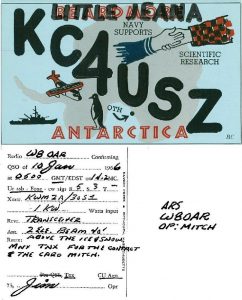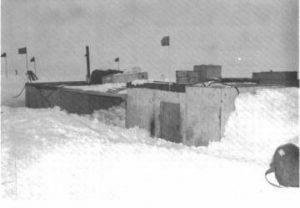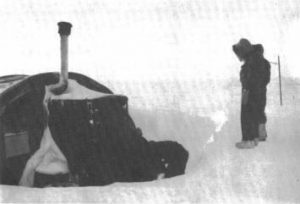 It was not an easy task to retrace the history of Little Jeana Station but thanks to our friend Bill Ashley KF5BRB who did
It was not an easy task to retrace the history of Little Jeana Station but thanks to our friend Bill Ashley KF5BRB who did
provide a QSL ofthis rare one, WAP is now in condition to issue to LITTLE JEANA STATION (aka Little Jeana Summer Weather Station) a brand new WAP
reference as USA-47.
The KC4USZ card , prove that an activity on Jan. 10th 1966 from this epic rare one by a QSO made with W8OAR!
US Station Little Jeana.
The Bulletin of the Antarctic US Projects officer (Vol.6 number 2-1964), signed by Rear Admiral James R. Reedy, USN United States Antarctic Projects
Officer, show a presentation of activities of the Government of the United States of America pertaining to the logistic support, scientific programs, and current events of interest in
Antarctica, published monthly during the austral summer season and distributed to organizations, groups, and individuals interested in United States Antarctic activities.
The data in the over mentioned issues suggest that Little Jeana was active from 3 oct.64 to 23 feb.65, from 2 oct.65 to 31 oct.65
and again from 1 dec.65 to 22 jan.66.
SUMMER WEATHER STATIONS REESTABLISHED
Prior to the first aircraft landing at the South Pole, on 31 October 1956, a summer weather and emergency-landing station (Beardmore I Station WAP USA-NEW) was established at the foot of
Liv Glacier . This station was later moved to the foot of the Glacier, from which it derived its name, and has been moved or rebuilt several times since.
When aircraft began to resupply Byrd Station (WAP USA-19), another summer weather station, Little Rockford (WAP USA-NEW), was set up on the flight path from McMurdo
Sound to Byrd Station. It has also been relocated, at 79°14′ South, 147°29′ West, on the Rockefeller Plateau.
Plans for the current season called for remodeling the 2 stations, using van-type buildings similar to those that have proved successful at Eights Station (WAP USA-Ø7).
Advantage was taken of the opportunity to shift the location of Beardmore Station (WAP USA-NEW) to 81°23′ South, 170°15′ East, about 125 miles north of the previous site.

At the same time the station has been renamed “Little Jeana Summer Weather Station” and officially opened on 5 October 1964. The installation consists of 4
portable units, 3 of which are arranged in a “U”. In one are the sleeping and eating quarters for the 3-mandetach-ment; in another are a diesel generator and a workshop; while
the third contains another generator and a wash room.
Picture aside (20 February 1964), shows an exterior view of berthing wanigan with messing wanigan in background at Little Rockford Summer Weather Station.
.
.

Wintering-over party shovelling out the James-way but at Beardmore Summer Weather Station for activating the station. (29 September 1961.)
The center of the “U” has been turned into a permawalk, and here the pibal dome is located. The fourth unit has communications equipment and is separated from the others
sothat it may, if needed, serve as an emergency shelter.
Little Rockford was reestablished the same day Little Jeana was opened. This installation has consisted of wanigans that were put in position in 1958 by tractors from Little
America and later moved to the present site by the same means. It is intended to remodel Little Rockford, along the lines of Little Jeana, later in the season.
Source:
Bulletin of the Antarctic US Projects officer (Vol.6 number 2-1964) – Ricerca Google
More details are available at: https://amrc.ssec.wisc.edu/usap/brockton/NCDC-WBAN.TXT
Dates: 1964 October 01, through 1966 January 31Location: 81° 23’ 00” South, 170° 45’ 00” West on Ross Ice ShelfElevation: 178 feet POBvVIIndex and Errata (1).pdf
Little Jeana was a “summer weather station”.
Bulletin 1, December 1964, reports:
Beardmore station will be relocated at 81° 23’ 00” South, 170° 45’ 00” West and renamed Little Jeana Station .
Two of such stations, one on the flight path between McMurdo and Byrd was named Little Rockford, while on the flight path from McMurdo to Amundsen-Scott the other one
was Little Jeana.
Bulletin 2, January 1965 says: Little Jeana Station officially opened 5 October 1964.
4 wanigans (Wanigan is by definition, a shelter used for sleeping, eating, or storage, often mounted in Antarctica on a sledge), typical formation 3 in U-shape, and the 4
th one separated for communications and in case of emergency. These four pieces were the setup for the use of 3 people. 2 for 1800-gallon fuel tanks to be installed (bladder
technology used instead).
Bulletin 4 says: “…. manned by 3 Navy aerographers who broadcast weather conditions hourly”. Summer support season = 1 October through 1
March.
Bulletin 5, 8 February 1965 says: Communications van returned to McMurdo, digging out of station commenced. On 24 February 1965
Little Jeana closed for the season, personnel and equipment moved to McMurdo, but as reported above, other documents clearly states the activities from
Little Jeana were: 3 oct.64 to 23 feb.65, from 2 oct.65 to 31 oct.65 and again from dec.
1st 1965 to jan. 22nd 1966.
TNX Bill Ashley KF5BRB for his invaluable help
Source: https://www.miragenews.com/climate-change-risk-to-emperor-penguins-607084/ where you can read lots more.
 Ce n’était pas une tâche facile de retracer l’histoire de la Little Jeana Station mais grâce à notre ami Bill Ashley KF5BRB qui l’a fait
Ce n’était pas une tâche facile de retracer l’histoire de la Little Jeana Station mais grâce à notre ami Bill Ashley KF5BRB qui l’a fait
fournir une QSL de ce rare, le WAP est désormais en mesure de délivrer à LITTLE JEANA STATION (alias Little Jeana Summer Weather Station) un tout nouveau WAP
référence comme USA-47.
La KC4USZ card , prouve qu’une activité le 10th janvier 1966 de cette épopée rare par un QSO réalisé avec W8OAR !
US Station Little Jeana.
Le Bulletin of the Antarctic US Projects officer (Vol.6 numéro 2-1964), signé par le Contre-amiral James R. Reedy, USN United States Antarctic Projects
Officier, montrer une présentation des activités du gouvernement des États-Unis d’Amérique concernant le soutien logistique, les programmes scientifiques et les événements actuels d’intérêt dans
Antarctique, publié mensuellement pendant la saison d’été austral et distribué aux organisations, groupes et individus intéressés par les activités antarctiques des États-Unis.
Les données des numéros ci-dessus suggèrent que Little Jeana a été active du 3 oct.64 au 23 fév.65, du 2 oct.65 au 31 oct.65
et encore du 1 décembre 65 au 22 janvier 66.
LES STATIONS MÉTÉO D’ÉTÉ RÉTABLIES
Avant le premier atterrissage d’avion au pôle Sud, le 31 octobre 1956, une station météo d’été et d’atterrissage d’urgence (Beardmore I Station WAP USA-NEW) a été établie au pied du
Glacier Liv. Cette station a ensuite été déplacée au pied du glacier, d’où elle tire son nom, et a été déplacée ou reconstruite plusieurs fois depuis.
Lorsque les avions ont commencé à ravitailler la station Byrd (WAP USA-19), une autre station météo d’été, Little Rockford (WAP USA-NEW), a été installée sur la trajectoire de vol de McMurdo
Son à la gare de Byrd. Il a également été déplacé, à 79°14′ Sud, 147°29′ Ouest, sur le plateau Rockefeller.
Les plans pour la saison en cours prévoyaient de remodeler les 2 gares, en utilisant des bâtiments de type fourgon similaires à ceux qui ont fait leurs preuves à la Station Eights (WAP USA-Ø7).
On a profité de l’opportunité pour déplacer l’emplacement de la station Beardmore (WAP USA-NEW) à 81°23′ Sud, 170°15′ Est, à environ 125 miles au nord du site précédent .

Dans le même temps, la station a été rebaptisée « Petite station météo d’été de Jeana » et a officiellement ouvert ses portes le 5 octobre 1964. L’installation se compose de 4
unités portables, dont 3 sont disposées en « U ». Dans l’un se trouvent les dortoirs et les repas du 3-mandat; dans un autre, un groupe électrogène diesel et un atelier ; tandis que
le troisième contient un autre générateur et une salle de lavage.
Photo mise à part (20 février 1964), montre une vue extérieure de l’accostage de wanigan avec en arrière-plan un wanigan qui déconne à la station météo d’été de Little Rockford.
.
.

Fête d’hivernage en pelletant le James-way mais à la station météo d’été de Beardmore pour avoir activé la station. (29 septembre 1961.)
Le centre du « U » a été transformé en permawalk, et c’est ici que se trouve le dôme pibal. La quatrième unité dispose d’un équipement de communication et est séparée des autres
afin qu’il puisse, si besoin, servir d’abri d’urgence.
Little Rockford a été rétabli le jour même de l’ouverture de Little Jeana. Cette installation est constituée de wanigans mis en place en 1958 par des tracteurs de Little
America et plus tard déplacé vers le site actuel par les mêmes moyens. Il est destiné à remodeler Little Rockford, sur le modèle de Little Jeana, plus tard dans la saison.
Plus de détails sont disponibles sur :https://amrc.ssec.wisc.edu/usap/brockton/NCDC-WBAN.TXT
Dates : 1er octobre 1964 au 31 janvier 1966 Emplacement : 81° 23′ 00′ Sud, 170° 45′ 00′ Ouest sur la plate-forme de glace de RossÉlévation : 178 pieds POBvVIIndex et Errata (1).pdf
La petite Jeana était une « station météo d’été ».
Bulletin du 1er décembre 1964 rapports :
La station Beardmore sera déplacée à 81° 23′ 00′ Sud, 170° 45′ 00′ Ouest et rebaptisée Station Little Jeana .
Deux de ces stations, l’une sur la trajectoire de vol entre McMurdo et Byrd a été nommée Little Rockford, tandis que sur la trajectoire de vol de McMurdo à Amundsen-Scott l’autre
était Petite Jeana.
Le Bulletin 2, janvier 1965 dit : Petite Jeana Station officiellement ouverte le 5 octobre 1964.
4 wanigans (Wanigan est par définition, un abri utilisé pour dormir, manger, ou ranger, souvent monté en Antarctique sur un traîneau), formation typique 3 en forme de U, et les 4< sup>
l’un séparé pour les communications et en cas d’urgence. Ces quatre pièces étaient la configuration pour l’utilisation de 3 personnes. 2 pour les réservoirs de carburant de 1800 gallons à installer (vessie
technologie utilisée à la place).
Le bulletin 4 dit : « …. piloté par 3 aérographes de la Marine qui diffusent les conditions météorologiques toutes les heures ». Saison de support d’été = du 1er octobre au 1er
Mars.
Le bulletin 5 du 8 février 1965 dit : Le fourgon de communication est retourné à McMurdo, le creusement de la station a commencé. Le 24 février 1965
Little Jeana fermé pour la saison, le personnel et l’équipement ont déménagé à McMurdo, mais comme indiqué ci-dessus, d’autres documents indiquent clairement les activités de
La petite Jeana était : 3 oct.64 au 23 fév.65, du 2 oct.65 au 31 oct 0,65 et à nouveau à partir de déc.
1er 1965 au janv. 22e 1966.
TNX Bill Ashley KF5BRB pour son aide précieuse
Info de la Source Publié * ICI
